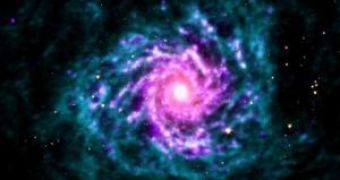Electromagnetic observations of the visible universe represent the most important and powerful tool while studying large structures lying in the near vicinity of our galaxy, regardless of the wavelength domain used in the process - optical, radio or X-ray and infrared. The HI Nearby Galaxy Survey, or THINGS for short, represents only one of the projects involved in the study of the galaxies located in the Local Group, and, after more than 500 hours of observation, THINGS succeeded in producing detailed images of about 34 galaxies situated at distances ranging between 6 to 50 million light years from Earth, totaling about one terrabyte of information.
The HI or hydrogen-one represents the astronomical term for atomic hydrogen gas.
The study conducted with the Very Large Array radio telescope mostly made observations on the radio emission given off by the atomic hydrogen. Considering the fact that more than 90 percent of the matter in the universe is still represented by hydrogen gas, such radio images constitute an extremely powerful tool in galaxy observations.
The vast majority of galaxies studied in the THINGS program have been previously observed in other light spectra, such as infrared and ultraviolet, with the help of space telescopes. Composite images of the galaxies in the three different wavelengths would now provide with a better image of the motion of the gaseous components, respectively the interactions between normal matter and dark matter, and how such actions influence the star formation process inside a galaxy.
Radio imaging succeeded in providing with an estimated density of the material required to trigger a star formation process, and showed that the causes which may lead to a new star formation process may differ widely, depending on the type of the galaxy. High resolution images provided by THINGS can also be used to measure the rotation periods of certain galaxies or to determine the random motions inside non-circular galaxies.
The inability of ultrafast computers to provide with models of the dark matter distribution was often associated, in the past, with the fact that dark matter mostly seems to have random motion inside galaxies. The THINGS program clearly proved that this is not the case.
Amazingly, although the astronomers had been previously able to make detailed observations of nearby galaxies, even details such as the true dimension of a galactic disk posed serious difficulties sometimes. The VLA has been able to precisely measure the location of the galactic disk edge in most of the galaxies studied.
A comparison between the galaxies in the near vicinity of the Milky Way and those seen in the remote regions of the universe also showed that masses of gas inside the much younger galaxies in the early stages of the universe are more agitated that those seen in older galaxies. The explanation for the phenomenon is relatively simple if you consider that the galaxies were much closer to each other in the past, thus galactic collisions took place with higher frequency. In fact, a separate study suggests that, during the young universe, the collision ratio between galaxies would have been at least four times higher than currently observed.

 14 DAY TRIAL //
14 DAY TRIAL //